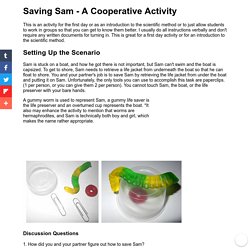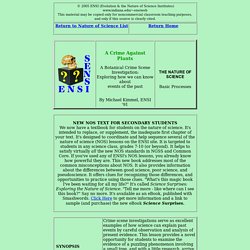

Save Sam! Saving Sam. This is an activity for the first day or as an introduction to the scientific method or to just allow students to work in groups so that you can get to know them better.

I usually do all instructions verbally and don't require any written documents for turning in. This is great for a first day activity or for an introduction to the scientific method. Sam is stuck on a boat, and how he got there is not important, but Sam can't swim and the boat is capsized. To get to shore, Sam needs to retrieve a life jacket from underneath the boat so that he can float to shore. You and your partner's job is to save Sam by retrieving the life jacket from under the boat and putting it on Sam. A gummy worm is used to represent Sam, a gummy life saver is the life preserver and an overturned cup represents the boat.
Discussion Questions. High School Teachers, Here Are 5 Smart Ways to Revamp Your First Day. Whether you call it syllabus day, procedures day, or teacher-lose-voice day, the opening day can be one of the most challenging days of the entire school year.

On this day, students across the nation sit like toads listening to the chirp of teachers. Class rules. Content maps. Policies. Oh here's an awkward name-game ice breaker. For most students, syllabus day is at best kind of boring, at worst useless. If you're ready for a change up—and ready to ensure students get something out of this day—consider these adjustments: 1. If I do all the cognitive work (a.k.a. reading the whole syllabus out loud), I get the cognitive benefit.
Instead, shift the cognitive ratio. 2. Another reason students hate day one is that they typically sit every minute of every class. Post various concepts or procedures from your syllabus around the room and have students travel to learn about each. Lesson: Laetoli Trackway Puzzle. 1.

Hand out (or show on your screen) the Sample Laetoli Topographic Tracks (shown below). Ask your students to describe what they see, giving several students an opportunity to respond without much (if any) comment. You may want to jot down short versions of each "observation" on the board or screen for later reference. Do this until at least 2-3 statements are made that are actually assumptions, not direct observations. ENSI/SENSI Lesson: Nat.of Sci.- Plant Crime Scene. Because this lesson provides an excellent opportunity to understand important elements of the Nature of Science , be sure to read our General Background Information, with our Rationale and our Approach, and tips for Presenting the lessons for maximum effect and Dispelling some of the popular myths about science.

In any of the discussions expected with the class, select a few key items (important concepts) that lend themselves to interpretation, and introduce class to the Think-Pair-Share (TPS) routine dealing with those items. This is how "Active Learning" is done. This lesson can be offered in the context of your introductory unit on the nature of science. The suggested websites can provide the botanical background to analyze the evidence. In fact, this scenario could be used as an opening experience for your students, to which subsequent experiences in class can refer. Prepare enough copies of the Case Report and photographs so that each team of 2-4 will have a set. Mystery tubes lesson. Adapted from two versions of this activity:The Mystery Tube — Author: Aaron Debbink, Partners Investigating Our EnvironmentTube Hypothesis and the Nature of Science — Author: Kirk Brown, science teacher, Tracy High School A version of this activity also appeared in the National Academy of Science's publication Teaching About Evolution and the Nature of Science.

Overview: This lesson serves as a good introduction to the nature of scientific inquiry. Students are asked to determine what the interior construction of a mystery tube looks like. Working in small groups, students pose explanations (hypotheses) for what they are observing and are asked to test their hypotheses. Lesson concepts: Grade span: 6-16 Materials: One Mystery Tube per two students — diagram and supply list belowScratch paper for drawing diagramsPackets/zip lock bags for building models (see step 5 below). Advance preparation: Make Mystery Tubes as shown below. Time: One class period Procedure: Amazon Fly. Filbert Abercrombie was, and perhaps still is, a biologist from Oxford.

His research was on the distribution of flora and fauna within the Amazon River Basin. The part that he loved most about his work was that he needed to spend months each year exploring and mapping some of the most remote parts of the Basin, following some of the smallest of tributaries. The remoteness of the area and the exploration really appealed to him, satisfying his sense of adventure and curiosity and at the same time giving him a certain sense of peace. There was only one thing that drove him up the wall...the masses of tiny flies that would forever pester him, getting into his eyes, nose and mouth. It drove him crazy! _doing-science_mstr.